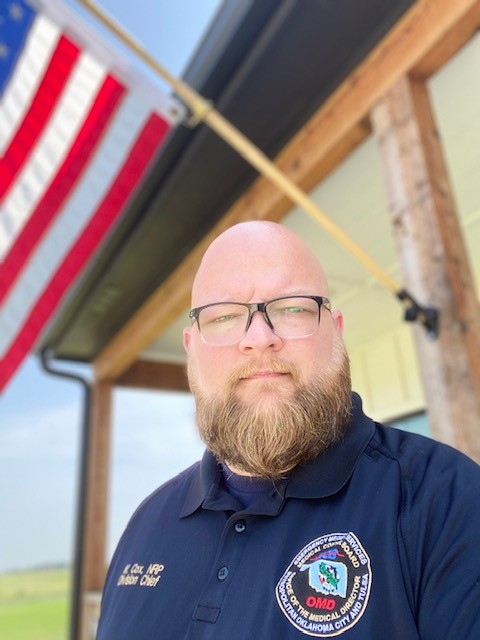ABOUT US MCB OMD
More than 4000 paramedics and emergency responders who serve the metropolitan areas of Oklahoma City and Tulsa are on the front lines of emergency medical care and treatment every day. Each year they respond to more than 215,000 calls for life-threatening incidents.
Our organization establishes medical directives to ensure patients receive the best possible care. The actions of the EMS providers can mean the difference between life and death. Our protocols and training are on the forefront of medical science, and ensure our region has life support personnel with the most extensive training to offer Oklahomans the best chances for survival.
Our Mission
Who We Serve
Metropolitan Tulsa & Oklahoma City
The Regulated Service Area, (RSA) which includes the greater metropolitan areas of Tulsa and Oklahoma City, encompasses 1030 square miles with a resident population of 1,213,096 people (2011 census). The Emergency Medical Services Authority (EMSA) provides Advanced Life Support (ALS) ambulance coverage to Tulsa and Oklahoma City and surrounding suburbs. The 9-1-1 centers of Tulsa and Oklahoma City combine to handle 215,000 medical calls annually, resulting in transport of patients to 27 designated hospitals. The EMS system is comprised of:
- 16 cities with signed EMS Interlocal Cooperation Agreements.
- A combination of urban and rural areas throughout the RSA. The largest city is Oklahoma City, which has a population of approximate 650,000
- Fire Department First Response (most fire departments within the RSA are Automatic External Defibrillator [AED] capable), Oklahoma City and Tulsa Fire Departments are currently providing limited ALS/First Response, and operate special units including water rescue, hazardous material, etc. All fire departments provide rescue services.,
- Emergency Medical Services Authority (EMSA) ALS Transport Agency.
- Tactical Emergency Medical Operatiors serving on Special Operations Teams throughout the RSA.
- On-Line Medical Control.
- Off-Line Medical Control
The RSA is currently a two-tiered system comprising of approximately 4,000 Paramedics, EMT-intermediates, EMT-B, EMT-Basics, FR, Law enforcement and on-site security staff FR/defibrillators, and approximately 100 On-Line Medical Control Physicians.
The Medical Control Board (MCB) is the medical oversight authority, and employs Dr. Jeffrey Goodloe and staff of the Office of the Medical Director, which includes 5 full-time employees. The Office of the Medical Director provides medical direction for the following metropolitan entities:
The EMS System serves the Cities of:
- Tulsa, OK
- Oklahoma City, OK
- Nichols Hills, OK
- The Village, OK
- Sand Springs, OK
- Jenks, OK
- Bixby, OK
- Berryhill, OK
- Valley Brook, OK
- Oklahoma Highway Patrol
CONTACT INFORMATION
Phone: (918) 596-3147
Fax: (405) 297-7199
Email: OMDOffice@emsa.net
Oklahoma City, Oklahoma
6205 S Sooner Road Oklahoma City, OK 73135
Tulsa, Oklahoma
1417 North Lansing Avenue Tulsa, OK 74106
The Medical Control Board
The Medical Control Boardis established by the Emergency Physician Foundations of Oklahoma City (Western Division) and Tulsa (Eastern Division). The Medical Control Board meets bi-monthly and is comprised of eleven physicians devoting volunteer service to the patients served by the EMS system for metropolitan Oklahoma City and Tulsa. They are dedicated to the men and women rendering emergency medical care as an Emergency Medical Dispatcher, Emergency Medical Technician (EMT)-Basic, EMT-Intermediate, or EMT-Paramedic.
The Medical Control Board is comprised of five emergency department physicians from each Division, and one physician from another specialty. These emergency physicians represent the busiest emergency departments in the areas served by the EMS system.
The following physicians served on the MCB during this operational and fiscal year:
Russell Anderson, DO – Hillcrest Hospital South (Tulsa) - Chair
David Smith, MD – University of Oklahoma Medical Center (Oklahoma City) – Vice Chair
Keri Smith, DO – Integris Southwest Medical Center (Oklahoma City)- Secretary
Amanda Celii, MD, FACS – Integris Baptist Medical Center/ NW Expressway (Oklahoma City)
Julie Curry, DO – St. Francis Hospital (Tulsa)
Jeffrey Johnson, MD, FACEP – Hillcrest Medical Center (Tulsa)
David Gearhart, DO, FACEP – Oklahoma State University Medical Center (Tulsa)
John Nalagan, MD, FACEP – Mercy Medical Center ( OKC)
Peyton Holder, MD – St. John Medical Center (Tulsa)
Matt Wood, DO, – St. Anthony Hospital (Oklahoma City)
Justin Davis, DO - Integris Baptist Medical Center/ NW Expressway (Oklahoma City)
Office of the Medical Director
The Medical Directors, the day-to-day recognized clinical authority in the EMS system, serving as such between times the MCB is meeting. Jeffrey M. Goodloe, MD, NREMT-P, FACEP is the Chief Medical Officer for all agencies receiving medical oversight from the MCB/OMD.
- To view Dr. Goodloes Biography, please select HERE.
- To view Dr. Gooloes Curriculum Vitae, please select HERE.
The MCB contracted with the Department of Emergency Medicine at the University of Oklahoma’s School of Community Medicine in July 2009 for physician medical director services. Substantial benefits to the EMS system and its patients are achieved through this arrangement, bringing research and educational capabilities from the University of Oklahoma, its emergency medicine residency program, and its collegial network of medical professionals.
Duties of the Office of the Medical Director
OMD professionals work daily to assist public safety agencies charged with emergency medical services responsibilities to fulfill those according to the clinical care standards established by the MCB. Medical outcomes determinations, individual medical care review, personnel education, personnel credentialing, equipment/vehicle performance review and inspection are just some of the myriad activities performed in support of excellence in pre-hospital emergency medical care.
All OMD Division Chiefs are particularly experienced and gifted clinicians and administrative leaders, guided by admirable work ethic. Each has served this and other EMS systems in a multitude of responsibilities, beginning with field service and progressing to their current oversight duties. The Administrative Assistant is responsible for OMD workflow logistics, organization, and spearheading additional service product lines. The Data Analyst improves community health and Emergency Medical Services system capabilities through data entry of critical illness and injury care delivered by EMS system providers. This data entry directly enables enhanced data analysis capabilities, leading to clinical care standards with greater health impact.
The Office of the Medical Director is comprised of the following professionals:
Dr. Jeffrey M. Goodloe
Chief Medical OfficerDr. Curtis Knoles
Associate Chief Medical OfficerDr. Patrick Cody
Assistant Chief Medical OfficerDavid Howerton, NRP
Division Chief- Medical Oversight- WestDuffy McAnallen, NRP
Division Chief- Medical Oversight- East
Matt Cox, NRP
Division Chief- Critical Care AnalyticsBill Justice, NRP
Special Operations and Outreach


